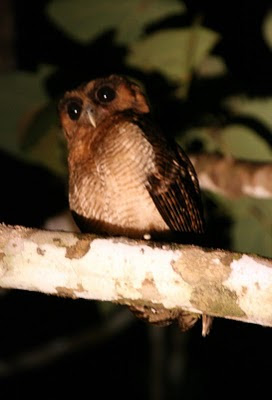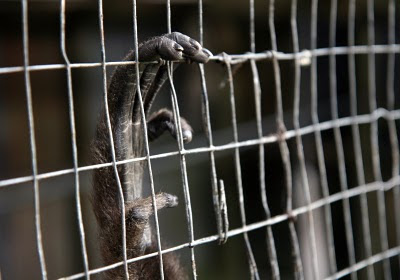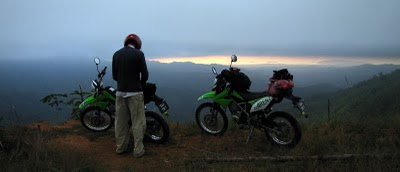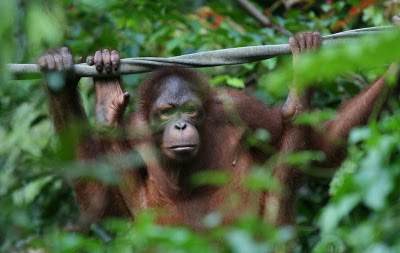Maybe it was the many David Attenborough documentaries? the astounding variety of flora and fauna found within the Bornean rainforest always evoked a feeling of awe that would resonate deep inside... does this really exist? on OUR planet ? what an amazing ecological system !
... or maybe it was the feelings of injustice surfaced by watching the doco in highschool of the nomadic indigenous Penan people of Borneo whom had there forests cleared and land stolen in the name of modern development and progress, just like the Aboriginal peoples of Australia and most of the indigenous peoples of the Earth.
The dream just seemed to grow and evolve, and die and get reborn again... and years and years of dreaming and envisioning I am now actually writing from the Island of Borneo...
As much as I'd love to set the scene of myself camped up in the canopy with a wireless internet connection, drinking water from lush tropical leaves and hanging out with orangutan and Hornbills, the reality of modern Borneo is worlds apart from our many preconceptions, I am actually in an internet cafe overflowing with young Malay boys playing computer games and speaking a language that I am slowly beginning to recognize.
And the reality of Borneo's seemingly endless tropical rainforest is that they have shrunk at a rate of 300 acres every hour for the past 50 years. Although I was aware of this reality, to see it with my very own eyes has been utterly confronting...
So, Although the past 2 weeks feels like more then a month. Here is a quick recount ...
Upon arrival I checked myself into the local dentist and received truly first class root canal treatment without any pain what so ever and the Dentist even gave me a contact in WWF for the river of life project for when we visit the East Coast of Sabah.
When Tony arrived he also needed some dental work and had a root canal in sympathy. At just $250 Australian dollars it was an affordable alternative to the 1000 plus job it costs back home.
We spent a couple of days at a local backpackers,
Tropicana Lodge, and have since called it our home whenever in Kota Kinabalu.
Highly reccomended at $7 a night including breakfast, it is also the only place in town that backs onto forest with a hammock to chill out in.
We met a Spaniard, Adrian, who has called Borneo his home for the past 3 months doing research into the effects of land entitlement and palm oil plantations on the indigenous peoples.
We shall soon travel up to the villages where he has been working and try to get some perspectives of the indigenous peoples efforts to claim native land entitlement and to keep up with the pace of modern society.
One of the must-do's in KK is to visit the night market. Rows of Fresh fish and Produce that seem to really go on for ever and ever.
Some of the local Malay food.
After a few days finding our feet, they began to get itchy… so we decided to hire trail-bikes (sorry mum and dad! It’s really the best way to get off the tourist trail and meet the locals… we never traveled for more then a few hours per day and never ever went over 80km an hour.
We began our motor bicycle journey with a recon mission up to the base of Mt Kinabalu and Poring Hot Springs. Mount Kinabalu is the highest peak in South-East Asia with a range of eco-systems from
Montane cloud rainforest down to the incredibly biologically diverse
Lowland dipterocarp forest.
One of the many Dipterocarp trees.
A species that is abundant in many of Borneos lowland forests.
Large emergent species, typically reaching heights of 40-70 m tall.
With a pretty hefty price to climb to the peak, we chose to explore the lowland rainforest and experience the tree top eco-system by doing the canopy walkway on sunrise. What a splendid introduction to the jungle of Borneo.
The sounds from the forest are like nothing I have ever heard before, even in Sumatra. We have connected with a like minded soul, John from Melbourne, who is recording the Malaysian rainorest with high quality audio gear. John has a background in film sound I can't wait to hear what he produces, and maybe we can put some on the blog to give you an idea of what a tropical rainforest eco-system sounds like.
Looking down from the canopy walk-way
After a few days on moped's we traded up to trail-bikes and continued our journey riding along the south west coast of Sabah where we eventually passed through an astounding 10 Immigration Border crossings!!!
Our trusty maps of Sabah & Sarawak
Tony rigged up the my HD video camera onto the back of his bike for some action shots.
Big thanks to Joel, Noah and the lads down at GoGoSabah (
http://gogosabah.com) for for setting us up with these two awesome Kawasaki KLX-150's and kitting us out with occy straps and raingear. They were incredibly fuel efficient using just a few dollars of petrol per tank (getting us about 250km).
We're going to contribute photo's and video footage to help them promote their new business. They have great energy and younger brother Noah is being trained up by Joel to start another shop in Sandakan on the East Coast.
Crossing one of many ferries into the kingdom of Brunei.
From Sabah into Sarawak across the river on a ferry into Brunei where stayed in beautiful Tamburong, a small river town surrounded by lush rainforest (Brunei still has 70% primary rainforest coverage).
Life on the river
From Brunei we crossed into Sarawak again and then back into Brunei and then across the border BACK into Sarawak!!!
I was good fun at first, we even went behind the scenes of immigration control.. But frustrations at the bureaucracy grew when they forgot to stamp upon re-entry from the south and eventually we spent more time sorting the Visa issue out then it took to get through the friggin’ country !
Mansil, the Brunei Immigration officer who personally attended to our many visa requirements.
If you ever find yourself intending to travel through Brunei,
please get a multiple entry visa and save yourself the many hours of paperwork.
Tony finding his visa at one of the many immigration checkpoints
Brunei, officially the
State of Brunei Darussalam or the
Nation of Brunei, is a country located in the north of Borneo
. Apart from its coastline with the south china sea it is completely surrounded by the state of Sarawak, Malaysia and in fact it is separated into two parts by Limbang which is part of Sarawak.
The main mosque in the capital, Banda Seri Bagawan,
complete with full external sound-system for your early morning aural delights
It is a muslim country and we were blessed with some fine meditation chanting at 5AM each morning, the dogs and chickens were all in on the act and before the sun was up, the whole town was praising Allah!
The city of Miri was our first stop south of the Brunei border, known as the Las Vegas of Sarawak for all the Brunei locals who like to party south of their border (alcohol is prohibited in Brunei).
The next morning we made our way south through what was an endless forest of Palm oil in every possible direction, or freshly cleared land that had just been planted out.
Coupled with the incredible pollution haze, I thought of the dinosaurs and what they must of endured when the sun glazed over some 65 million years ago after a meteor hit the Earth.
The little forest that remained in areas was heavily logged, fragmented and degraded. Testimony to the fact that Borneo supplies more then HALF the worlds tropical hardwood timber supply. Sadly there is very little Primary (Old growth) rainforest remaining.
An ongoing practice of land clearing to fuel economic growth
Lambir Hills National Park
About 30km south of Miri we stopped for the afternoon at
Lambir Hills national park for our first swim in the Borneo rainforest under a lush waterfall! A total grounder and energy cleanser after having rode through the never ending apocalyptic palm oil wasteland.
A close relative of the common Mango (
Mangifera genus) had germinated and was stretching for the light.
After spending the afternoon around the waterhole we continued on another 89km to
Niah Caves National Park right, arriving to another stunning sunset thanks to the wonderful light dynamics fueled by a combination of forest fires and general south-east Asian pollution.
Utterly magical.
No need for guides, just pay the $3 entry fee and 30 cent ferry crossing into the park where a boardwalk leads you through
Mixed Dipterocarp Forest into the incredible system of limestone caves.
NIAH NATIONAL PARK
Tony on the bottom left trying to capture the truly uncapturable
An Iban Longhouse just inside the great cave entrance
A truly astounding system of massive caves, full of bats and swiftlets, with 40,000 year old paintings from Neanderthals and the Iban people still live within the park and are allowed by Sarawak Forestry to collect the birds nest for soup, which sells for $50AU.
Unfortunately the park was too small to provide habitat for Orangutan and although a few gibbons and monkeys are said to survive, we never saw a single primate, maybe they ended up in the birds nest soup?
There was a section of the caves that was completely dark for 600 meters. After venturing halfway with our head-torches we stopped, sat within the peaceful darkness and Tony recorded me playing some American Indian flute with lush water dripping in the background
The reverb was incredible and a few other cavers from Japan stopped and thanked us for the vibrations, with a broken English comment ‘Ahh, that vewy soul searching music, thank you thank you’ indeed it was a special place to sing a song from the moment. (we'll upload soon).
And so after experiencing Niah, we began to seriously consider making our way to into the world heritage national park, Gunung Mulu, containing the worlds largest cave. (The one in David Attenborough’s Planet Earth series where over 3 million bats exit the cave each night).
Our intention was to ride through the logging trails and take longboats up into Mulu from Miri, but the rivers were low and the journey was said to take over 12 hours.
So we rode into the Miri Airport early sunday morning and booked our flights for the afternoon.
MULU NATIONAL PARK
Found within the Interior of Sarawak, this park has the highest protection in Borneo and is also the heartland of the once nomadic Penan people who have almost totally been settled into longhouses and converted to Christianity, although there are still a few nomadic Penan within the park boundaries.
As we launched off the runway on our MASwing flight, almost instantly the Palm Oil plantations that have replaced once lush rainforest appeared. Rows upon rows of one single species,
Elaeis guineensis, feeding the insatiable global demand for this high yield oil that is found in 10% of supermarket products.
Eventually palm oil gave way to heavily logged secondary rainforest, and many areas that have been recently cleared for palm oil. Along the rivers were hundreds of logging camps and into the forest a network of roads and tracks. I can only imagine what a 40 year time-lapse satellite photography would look like as this Island is cut and leveled so that the economy can ‘develop’ (but at what cost?).
As we flew further into the Interior, on the horizon Mulu National Park was a sight to behold, covered in mist, the creation of its own regional micro-climate. Cloaked in the lushest of lush lushness…
After landing in the tiny airstrip, Tony, myself and 4 German travellers jumped in the back of the local taxi
(a 4x4 ute) and made our way to the home-stay, a longhouse on the river complete with chickens, ducks and a pig that was eventually sacrificed for the Easter celebration.
This was a place where the river is the main artery of everyday life, including having a bath !
Gunung Mulu National Park is the most lush tropical rainforest I have ever seen, the sounds that emanated day and night was a completely alien aural experience.
So many different varieties of flora and fauna, beautiful Raja Brookes bird wing butterlfies in their dozens, stick insects of every shape imaginable, some beautiful tree snakes with intense psychedelic patterns, Gecko’s that are striped like a zebra, Hornbills with there big horny looking bills and of course the mass exodus of over 3 million bats on sunset, a swirling whirl of collective consciousness.
Out the front of our home-stay where we saw over 3 million bats leave on sunset.
However we didn’t see a single primate and eventually discovered Orangutan were hunted to local extinction in the 1950’s. The flora was astounding, 1000’s of species all co-existing to create an eco-system that generates 70% of the local rainfall and is home to more species than you could poke a stick-insect at.
Birds Nest Fern
Raja Brookes Birdwing
Clearwater Caves
Where clearwater caves comes out into the rainforest,
an underwater river system that suddenly emerges from underground.
Looking out into the surrounding rainforest
amazing holes in the roof of the cave would reveal where the light is penetrating
and forming suitable conditions for plant life to begin.
The Mulu Canopy Skywalk at 480 metres is the longest tree-based walkway in the World.
Some of the trees were absolutely mammoth!
Raja Brookes Birdwing Butterfly
Our only issue with Mulu National Park was the need for guides and the timing of some of the tours (for instance there was no way to do an early morning canopy walk (which is the best time for wildlife and the light is perfect for photography). There were a few other issues raised, including the discovery that the park, although world heritage listed, is actually run by a foreign company outside of Sarawak Forestry.
Swimming in the river next to our longhouse was a major highlight and listening to the amazing sounds from the forest at night was a sound to behold. This is a place that one must spend at least a week I feel, as our 3 nights and four days seemed to fly by like a Hornbill on heat.
The flight back revealed more forest destruction, huge areas of land that were freshly leveled for palm oil expansion, the indigenous peoples that once lived sustainably within these eco-systems now moved into settlements struggling to survive.
After riding back to KK we totaled 1500km on trail bikes in the north of Borneo, an incredible way to get off the tourist trail and meet every day local people, who have been a constant source of hospitality and warmness. We’ve even been learning a little Bahasa Maleyu (the Malaysian language).
Under the surface of it all there is a darkness that is hidden which I cannot ignore.
Unfortunately in the governments eagerness for economic development (the driving force and ultimate goal of modern civilization) there is an ongoing story of not only ecological but also cultural devastation.
The indigenous people of Borneo, especially the Nomadic Penan peoples, have been almost totally displaced from their land by the cronyism of government and big business interests. Logging companies and Palm Oil companies, backed by the Malaysian army, have been at work behind the scenes in the interior of Borneo.
Bruno Manser was a swiss activist who lived with the Penan people for 6 years in the 80’s and returned to the west to raise awareness of his peoples plight. A fearless activist who put Borneo on the map, he returned to Borneo in 2001 and completely disappeared; obviously a major threat to continued logging and clearing of the Penans rainforest home.
Along with Bruno, a series of Penan activists have disappeared over the past few decades under suspicious circumstances.
This is a story that is not confined to Borneo. My own country Australia has a black history with an equally devastating path, stripping the heart out of the Aboriginal People, their connection to the spirit of the land.
Plans are underway for a massive dam project in the heart of Sarawak in northern Borneo that will displace thousands of indigenous peoples from their ancestral lands!
The paradigm with which the government and big business view the world around them leaves little room for compassion or justice.
As Chief Seattle says,
This we know: the earth does not belong to man, man belongs to the earth. All things are connected like the blood that unites us all. Man did not weave the web of life, he is merely a strand in it. Whatever he does to the web, he does to himself.
And the Indigenous people are apart of this web too.
However there have been some
positive stories surfacing in the past week, with the Malaysian court honoring indigenous connection the land and granting them Native Entitlement in a win against a foreign owned palm oil company.
Check out some the links below and educate yourself on these issues.









































 .
.






























